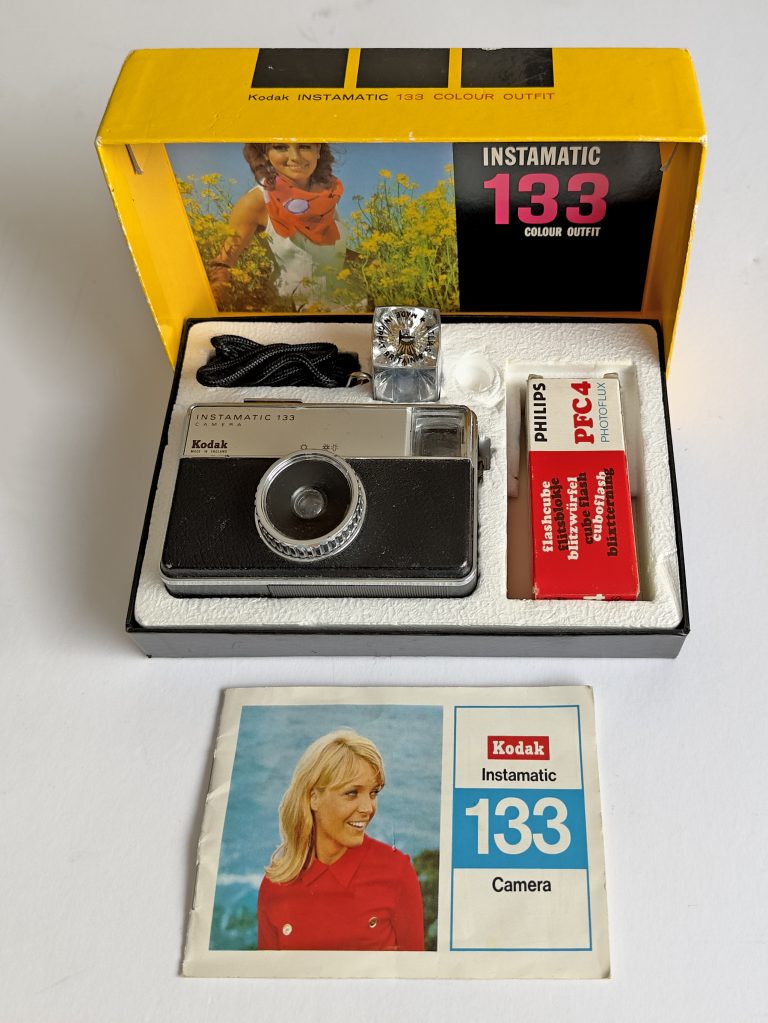I have always had a fascination with British cameras. In the 1950s, when my Dad started to take up photography, he naturally made a British camera his first. The British camera industry was flourished post war, as imported cameras from Germany (which was yet to fully recover its manufacturing base) were expensive and severely restricted by import controls. Japanese cameras were unheard of at this time (although they were beginning to be made).
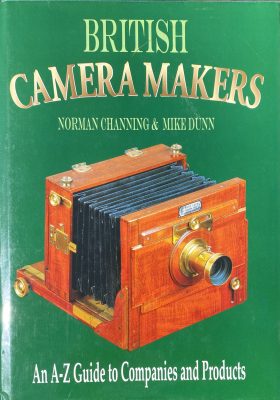
The above book has 385 indexed entries since the early 19th Century so there were quite a lot of British camera makers, possibly more than any other country in Europe. Unfortunately the abolition of import quotas in the 1960s put paid to what was left of the British camera industry. Nearly all of the companies disappeared, the handful remaining survived because they no longer made cameras!
Output at the end of the 1800s was prolific, for example in 1898 Lancaster claimed to ‘make’ 200,000 cameras a year making them the world’s largest camera makers.
I will give a potted history of the British cameras in my collection.
1903 LANCASTER ROYAL INSTANTOGRAPH (¼ Plate)
This camera belonged to the late father of my piano teacher (a Miss Dudley) when I was a child (c.1960) and she gave it to me to start my collection together with a collection of plates taken in old Heswall. My parents insisted I gave the plates back, so I don’t know what happened to them. It included a front mounted shutter, a lens, and a few plate holders. At the time this was made, J. Lancaster & Son of Birmingham, who at the time were the largest camera manufacturers in the world!
I had some trouble identifying this camera so I contacted David Purcell of Red Bellows (www.redbellows.co.uk). I quote his helpful reponse “I believe your camera is likely to be a Royal Instantograph field camera, introduced in about 1903 or thereabouts, and a little later than I had anticipated given the style of the bellows that it employs that are square section, common before this time but generally being replaced with chamfered corners that were less prone to developing pin holes. It is fairly unusual to see a camera of this field format in ¼ plate size. Most are ½ plate. I assume the plate on the body just records the maker’s name? Generally Lancaster cameras would carry a second with the camera name as well but apparently not in this case”.
The original lens panel had a bulb operated roller blind shutter. As the blind perished, it became inoperable and attempts at a repair failed, I was left with a box of bits. Fortunately a jumble sale brought to light an almost identical shutter which was easily fitted by swapping the lens mount fittings and refitting the original lens which is unmarked.This shutter is made by Thornton Pickard. Thornton Pickard were based in Greater Manchester, and they made shutters which were fitted to many cameras in the early 1900s. It carries a plate marked “Fred V A Lloyd, 5 South John St., Liverpool”. It is cocked by pulling a tasselled cord and released by a bulb which has long perished.
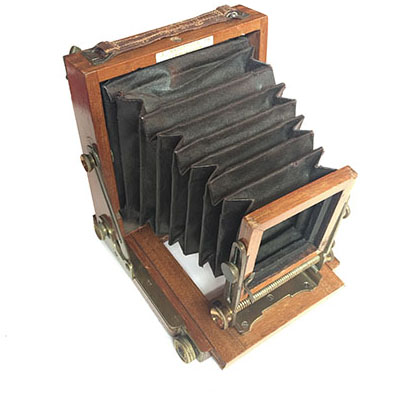

1905 TICKA Camera
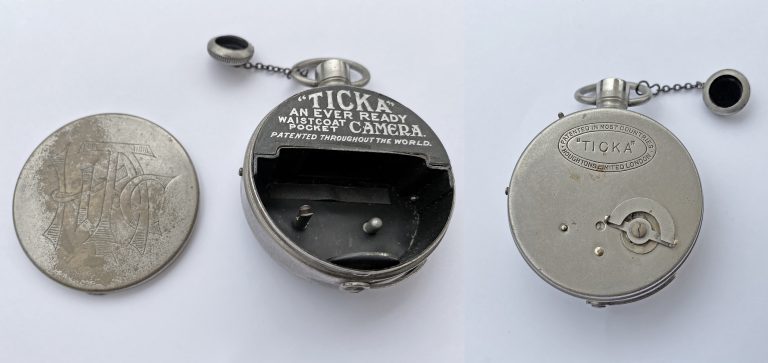
The Ticka camera was a watch-shaped “spy” camera made by Houghtons of London (makers of Ensign cameras) between 1905 and 1914. I bought this as I have owned the instructions for many years (although so far I can’t find them)! It was designed by Magnus Niéll, who also designed some other Ensign cameras (see below). He patented this camera in 1904 and it was manufactured in the UK by Houghtons, and in the USA by Expo. It uses special 17.5mm film supplied in special cassettes and was very popular at the time.
1910 Ensignette Camera
This is quite interesting in that it was very successful, many 1000s being sold. It was also designed by Magnus Niéll as was the Ticka (see above). It was an all metal bellows camera which folded into a vest pocket size camera (like the Kodak VPK with which it competed). It took the Ensign only E1 Roll Film (1 1/2 x 2 1/4). It was fitted with a simple achromatic f11 lens with 3 apertures and a fixed speed shutter. This is an early model, later iterations having more sophistication. The second picture shows the original box, leather pouch and instructions. The diminutive size of the camera also shows, as it is dwarfed by the other items!
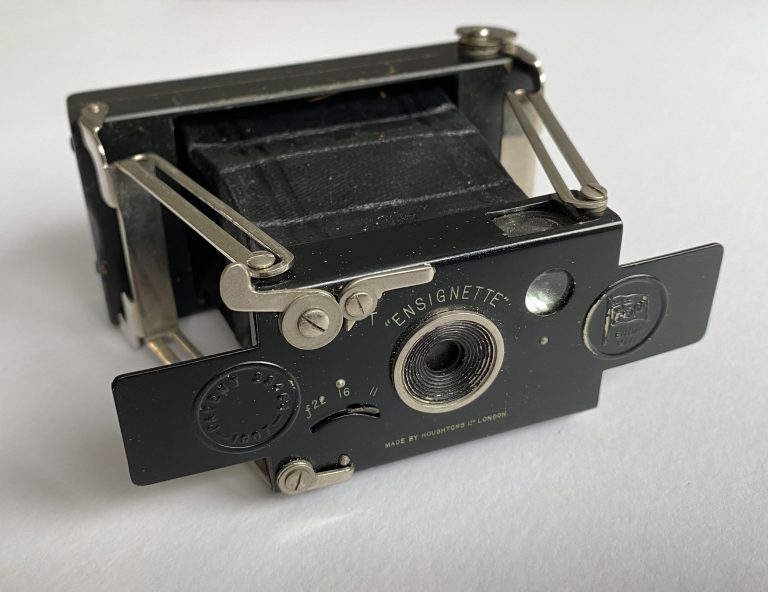
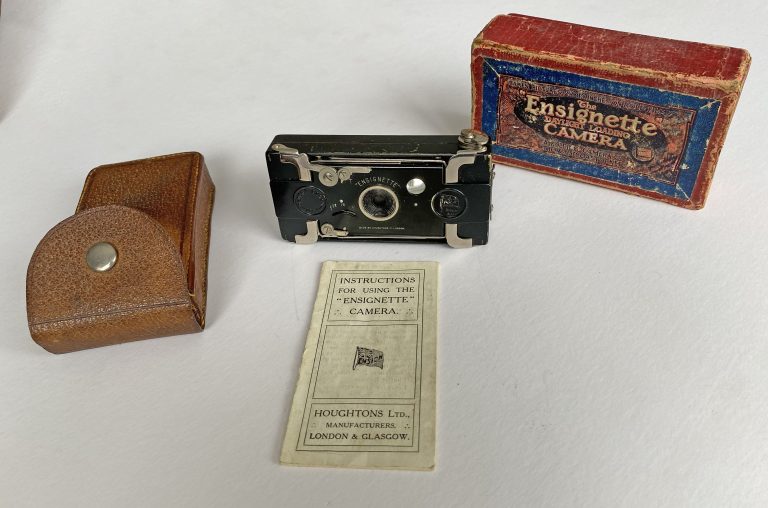
1913 APTUS Camera.
This “Ferrotype” or “while-you-wait” camera was made by Moore & Co. in Dale Street, Liverpool. They ceased trading as late as 1982.
According to Early Photography “This is probably the most popular of the ferrotype cameras. It produced quite large photographs similar in size to the earlier carte de visite. It would have been used at fairgrounds and the like. The plates are loaded into the base of the camera in a box. The plate is lifted into the focal plane by bringing down on to the plate an arm with a suction pad, a rubber bulb works the suction. After exposure the plate drops down into the developer/fixer solution.”
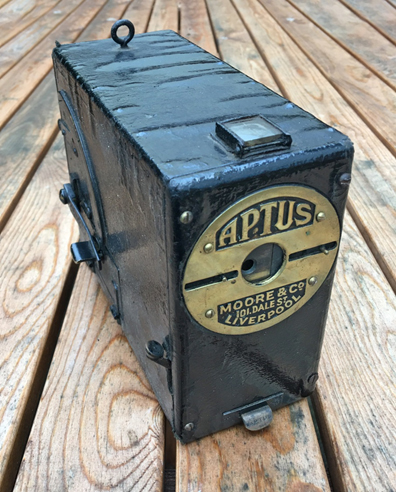
1929 Junior Box Ensign
According to Red Bellows: “The Junior Box Ensign camera was sold by Houghton-Butcher as part of its range in the early 1930s. It is the first camera listed in an Ensign catalogue for 1932 and is described as a “reliable camera of simple design”, and was sold for a very modest price, which was about a third of the cost of the cheapest folding camera in the same catalogue (the Ensign Pocket “Twenty”). The 1932 catalogue also lists a portrait attachment, a case and a tripod attachment as available accessories.
The Junior Box Ensign camera was also made available through several different premium schemes, where the camera could be acquired in exchanged for some form of coupon or token. The camera often turns up with original postal packaging and sometimes with supporting documentation. A particularly popular scheme was run by John Bull magazine, where of course the initials on the front of the camera conveniently matched that of the magazine”.
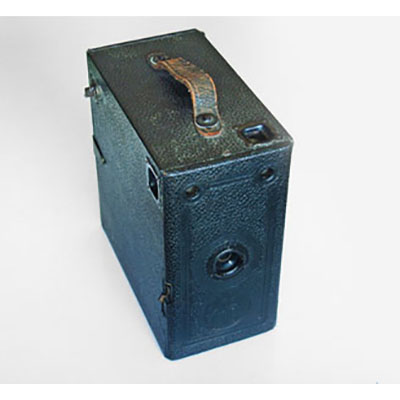
1925 Kodak Vest Pocket Model B
Most Kodak cameras were made in the USA, but some were made over here as well. This was a primitive folding bed camera for making 4×6.5cm exposures on 127 film. It was also marketed as Boy Scout Kodak and Girl Scout Kodak with new front plate designs by Walter Dorwin Teague. A coloured version was branded Kodak Petite. Its lens was a doublet in a rotary shutter, or a Kodak Periscopic lens in a Kodak shutter. The lens typically had four apertures, set by a thumb-wheel on the side of the shutter block, and numbered 1-4. The Model B had to be loaded through the front side, after removing the whole bed and bellows unit. It was produced from 1925 to 1934. It has the “autographic” feature, the slots for the autographic ‘pen’ are visible although the pen is missing.
These cameras was used by Mallory and Irvine in the fated 1924 Everest Expedition. Irvine’s camera was never found. As it may have images of the summit it would become the most famous camera in the world, if discovered!
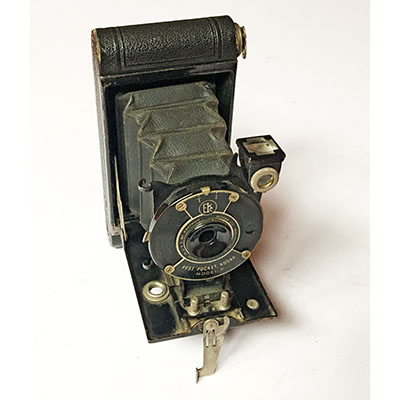
1930 KODAK No. 2 Hawkette Brown Bakelite
This beautiful and unusual camera was the first Kodak camera to be made entirely of plastic. It was assembled in Harrow from a bakelite body made by the well known radio manufacturer E. K. Cole (Ekco). Other components probably came from Rochester in the USA. The Hawkette was never made for sale to the public, instead, according to RedBellows “given away under premium schemes for a number of products including magazines, cigarettes and Cadbury chocolates”. It was only available as such in the UK.
There was no No.1, the “2” referred to the use of 120 (1″2″0) film!
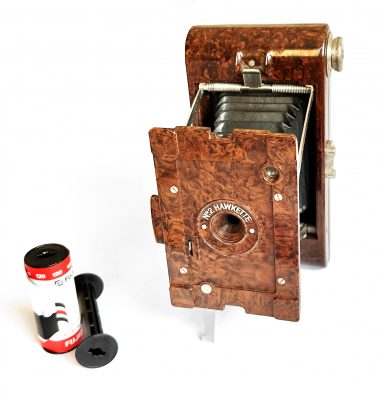
1932 No.1A Pocket Kodak
Another British made Kodak. According to Historic Camera “The No. 1A Pocket Kodak was manufactured from 1926 to 1932. This camera took twelve exposures, 2 1/2 x 4 1/4 inch size, on no. A 116 film without reloading. There were various lenses available for this camera including : -Meniscus Achromatic lens and Kodex shutter, speeds 1/25 to 1/50 second ($11.00) -Kodar f7.9 lens and Kodex shutter, speeds 1/25 to 1/50 second ($14.00) -Kodak Anastigmat f6.3 lens and a Kodak Diomatic shutter, speeds up to 1/100 second ($19.00) Constructed with a strong aluminum body and covered with a durable material. The metal parts were finished in nickel or black enamel. Features included a black bellows, autographic feature, worm screw focusing device, focusing scale, reversible brilliant finder, and two tripod sockets.”
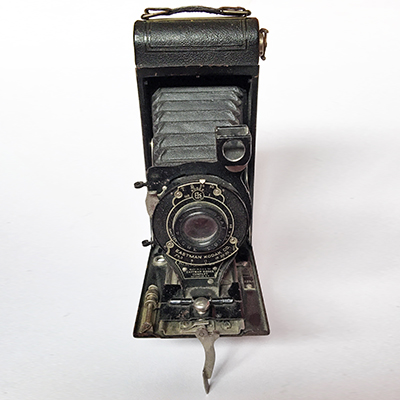
1933 Kershaw SOHO Pilot
According to Art Deco Cameras “The Soho Pilot Camera was manufactured by the Kershaw Manufacturing Co. and was sold through Soho Ltd. It was capable of capturing eight 2¼ x 3¼ inch (6×9 cm) sized images on standard 120 film. It was constructed of black Bakelite with black bellows. It was designed with art deco styling including a octagonal face and a basket weave pattern impressed on the body. The most charming aspect of this camera is the sunburst motif on the rear, surrounding the red window.”
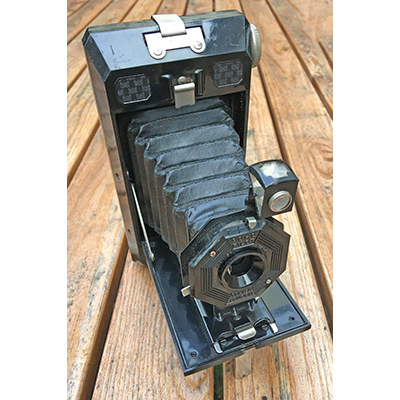
1937 Purma Special
The Purma Special was introduced in 1937. It was a Bakelite 127 roll film camera using a gravity controlled shutter. Horizontal gives medium speed, vertical with winding knob down gives slow, and vertical, knob up, fast.
The Purma company (named after the founders Tom Purvis and Alfred Mayo) was based in London. This camera was made almost entirely of Bakelite, apart from the glass lens, plastic viewfinder optics and shutter & spring mechanisms. Styling was apparently due to Raymond Loewy’s London Office. This example is like new – remarkable for a 84 year old camera.

1950 Agiflex II
The Agiflex was an early British postwar 6×6 SLR, made by Agilux. It was derived from the British WWII military aerial camera ARL that was in turn derived from the German Reflex Korelle. The camera’s focal plane shutter has speeds from 1 sec. to 1/500 sec. and flash synchronization. The finder is a big waist level reflex finder, with hinged magnifier and eye level setting. It has a lens mount for interchangeable lenses.
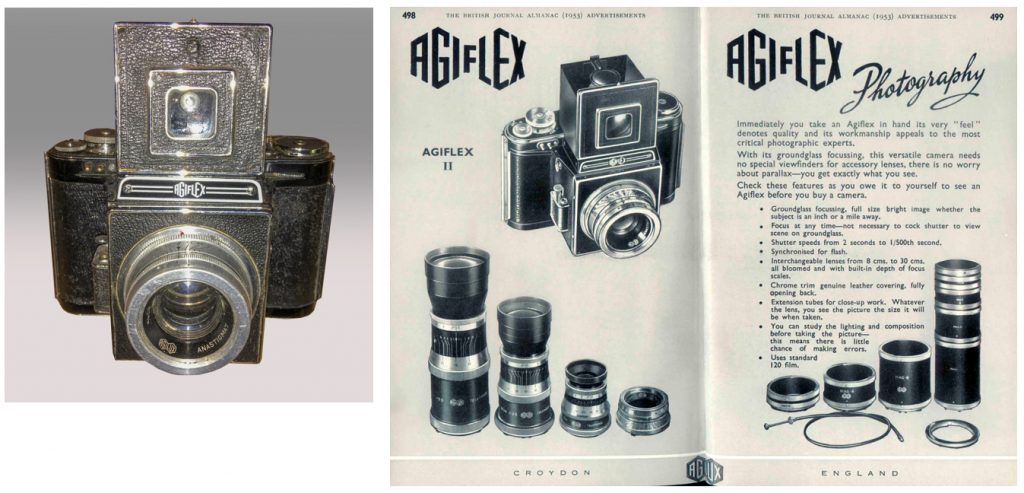
1950 ENSIGN Selfix 16-20 (Model 2)
According to Camera-Wiki “The Ensign Selfix 16-20 is a folding camera made by Ensign. It uses 120 film or 620 film and can take sixteen 6×4.5cm frames per roll. There are two distinct body styles of the camera. The second body is easily distinguished from the first by the albada viewfinder and depth of focus scale on the other side of the top plate from the winding knob. The second version also has double exposure prevention. Both versions have a 75mm f/3.5 Ross Xpres lens in an Epsilon shutter, and an additional tripod socket for landscape format on the front with a screw cover insert. The Albada version has a curious shutter release button, containing a sharp spike, which pricks the finger if the button is pressed without first setting the shutter!”

1950 Ilford Advocate
This 35mm camera was made for Ilford by Kennedy Instruments, wholly owned subsidiary of Ilford Ltd. It is quite unusual with its cream finish, and was also beautifully made. The lens is a 35mm Dallmeyer f4.5, and the shutter has 5 speeds ( 1/25, 1/50, 1/100, 1/150, 1/200, and bulb). The lens quality is reputedly good. Good sales meant other lenses were fitted (as Dalmeyer had difficulty in coping with the demand) such as Wray and even the German Zeiss Tessar. The shutter button is the lever just under the top plate, and the cable release socket is lower down.
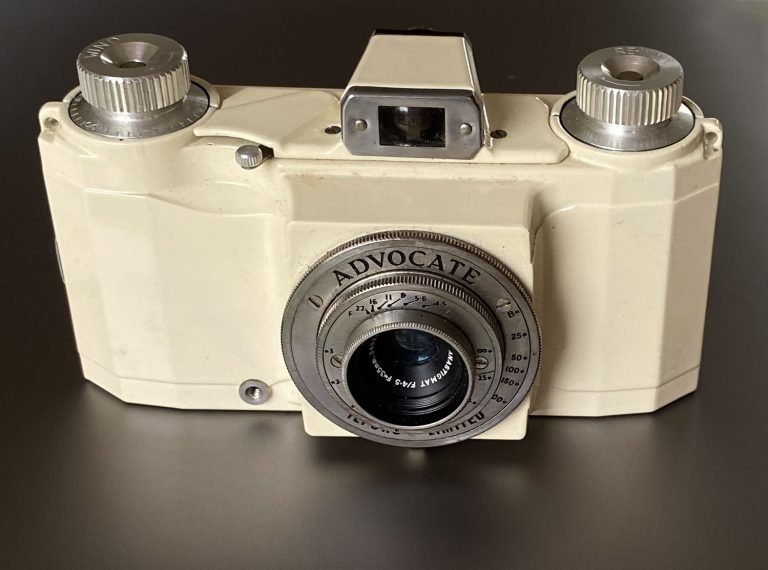
1951 Wrayflex I
This unusual camera was a British effort to make a 35mm SLR. To save money (although it was still expensive) they used 2 mirrors instead of a pentaprism, so the image is reversed and not very bright. It has a full complement of speeds from ½sec to 1/1000th sec in the focal plane shutter. The Wray lenses had an excellent reputation. Wind-on was by a fold-out key in the centre of the bottom plate. This works surprisingly well, except when mounting on a tripod! Images are 24 x 32mm which gives the same ratio as standard 1/4 or 1/2 plate photographic paper and 40 images per film. This was abandoned in model Ia, and model 2 has a normal pentaprism. Very rare,.
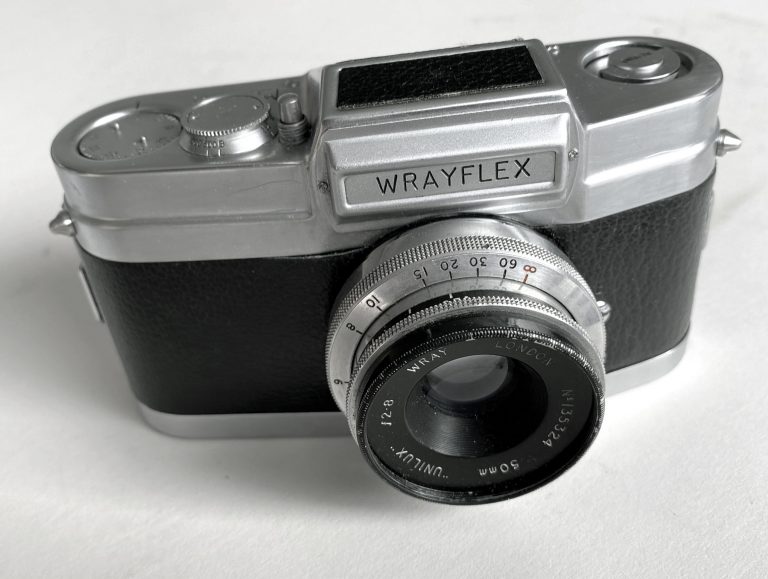
1952 Agilux Agifold
The Agifold was my Dads first camera which he bought in 1951. I hope that this example is similar (I have no photos of the original which he sold in 1952). It has a non-coupled rangefinder and an extinction exposure meter.
AGI (Aeronautical and General Instruments Co. of Croydon, England) which is still in business, formed a civilian camera making division in 1946. They made aerial cameras. during WW2. The company abandoned camera production in the early 1960s
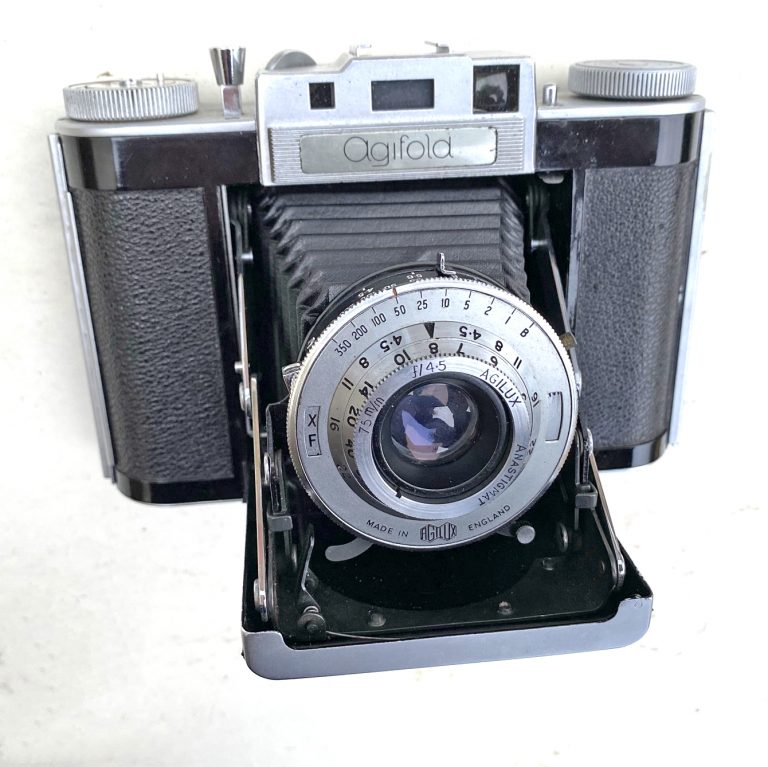
1952 MPP Microcord
This was a copy of the Rolleicord (after the war German designs and patents were taken as war reparations). The Ross Xpress lenses are reputedly better than the Zeiss equivalents, and the Microcord is supposedly better made than the later and more advanced Microflex.
MPP (Micro Precision Products) was formed in 1941 and made cameras until 1982. Its origins are related to the loudspeaker company Celestion which is still trading.
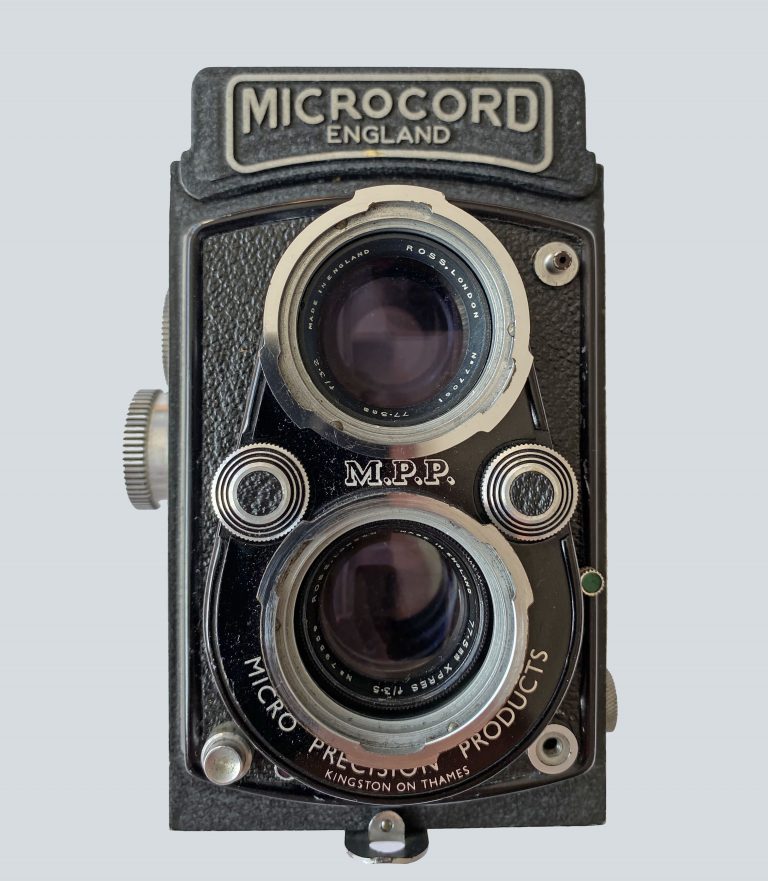
1953 Ensign Ranger Special
Ensign Ranger is a series of 120 film vertical folding cameras made by Houghtons in England. The Ranger has a similar body to the contemporary Selfix 8/20, but with a cheaper lens and shutter. The body has a folding frame finder. The top plate carries the film advance knob, and a similar knob on the feed spool and the finder; the shutter release is a small button set radially on the edge of the shutter block. The knobs lift to release the film spools.The 1953 Ensign Ranger Special had a chromed top-plate and a Rosstar or Ensar f/4.5 lens in an Epsilon four-speed shutter, costing £13-18s-3d. The Special had an albada optical folding finder, and provision for 6×6 as well as 6x9cm frames.
This example is in superb condition.
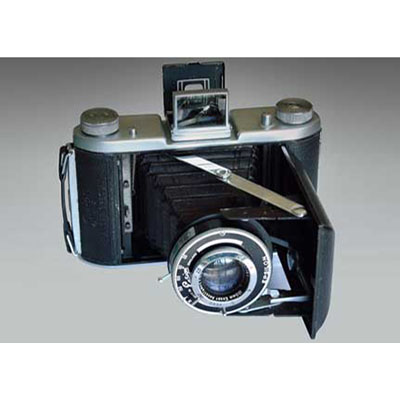
Reid III Type 2 (flash synchronized)
This is no longer in my collection although I owned it for around 20 years. In the end it became too valuable, I bought it for £100 and sold it for £800 on eBay to a Canadian to pay for a new Canon EOS300D.
Although a close copy of the Leica IIIb the Reid camera was designed in-house in Imperial measurements and to much tighter specifications than Leica used. The camera was unquestionably the finest made British camera in terms of the quality of its engineering, reliability and body finish but its origins as a copy meant that the design was neither new nor original in any respect except for the front mounted dual flash sync sockets fitted as standard on many cameras.The Reid camera in modern times, due to its precision engineering and build quality, has progressively moved to a top ranking in the eyes of collectors and now regularly fetches from $2,000 to $3,000 with its superb Taylor Hobson 2″/f2 lens.
Recently I did an internet search to see if it was mentioned (body number P2866) but found nothing.
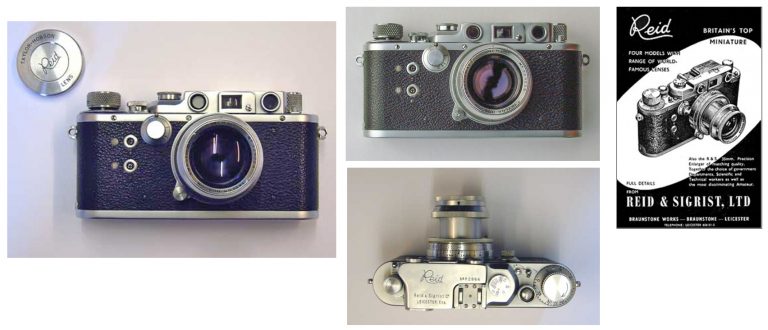
1955 Coronet Super-Flash
Coronet Box Cameras are medium format 120 film cameras made by Coronet (F W Pettifer) in Birmingham, England. There are several other Coronet Box models also made by Tiranty in France. This means that the same camera model could be found either British made or French made. All of the Coronet box camera models are in medium format, 6x9cm frame with roll 120 film. They have a simple one speed spring rotary shutter. These box cameras are offered with various meniscus type lenses.

1957 KODAK Brownie 127 (Second Model)
The Brownie 127 was, in the UK, an extremely popular plastic snapshot viewfinder model for 127 film made in England by Kodak Ltd. From introduction in 1952, over a million had been made by August 1954, and the series continued to sell many more millions. This second version had vertical lines on the sides and a flatter top. There were many small changes of faceplate and detailing; some had cream controls, later models having grey. An experimental white version, with a silver top, was made and only sold in Jersey in the Channel Islands – in c.1959; it was not successful, as the colour dirtied very easily.
It was fitted with a plastic F11 Dakon lens and a rotary shutter, and took pictures 6 x 4cm.
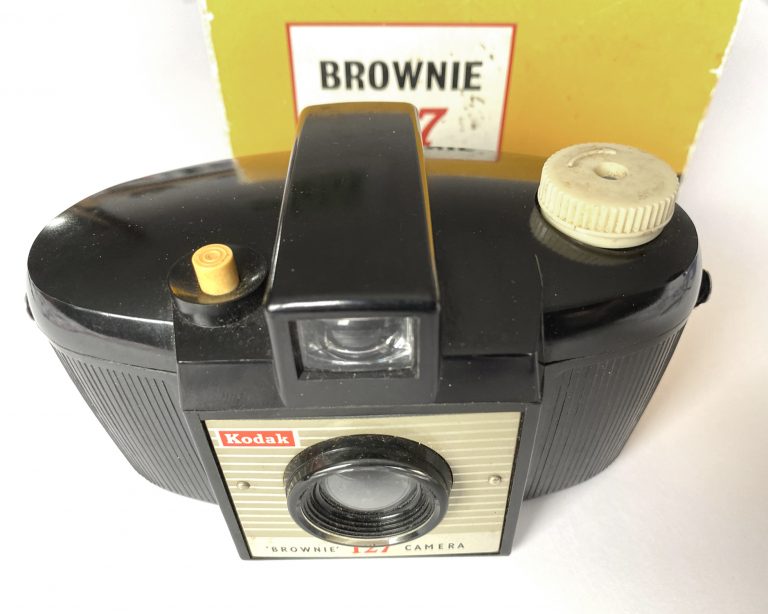
1958 ENSIGN Autorange 820
The legendary British Ensign Autorange 820 was made from late 1955 until the company folded around 1960, and was their top-of-the-range 6 X 9 120 folding camera. It had the same fine F3.8 4-element Ross Xpres lens and Epsilon 9-speed leaf shutter as the Selfix 820, but had a coupled rangefinder thrown in.
The renowned British photographer Edwin Smith used an Autorange for his Continental photographs.
The 1956 BJP Almanac says it cost just under £53, so not many were sold when the Selfix 820 cost about half that. The resulting scarcity of the Autorange 820 in today’s collecting market means a really nice one could fetch upwards of a thousand pounds. In 2011, one sold on Ebay complete with ERC, for – believe it or not – £2,284!!
To see a lovely YouTube video click here.
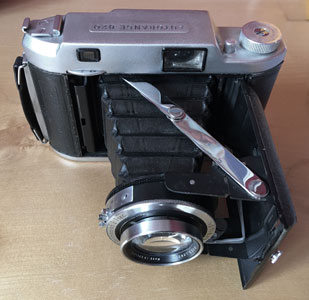
1958 Agilux AGIMATIC
This camera has a around the lens film advance, similar to the German Werra. Like the Agifold it has an uncoupled rangefinder and an extinction exposure meter.
They were quite well made, but don’t fetch very much money on eBay.
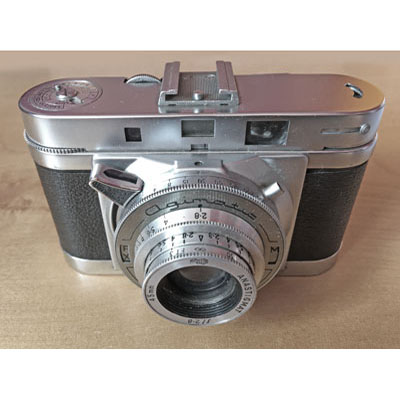
1959 Kodak COLORSNAP 35
This is a 35mm version of the UK made Bantam Colorsnap. The 43.9mm f3.9 Anaston lens is set in a single-speed shutter, with an aperture scale marked in weather symbols and EV numbers. The underside of the lens barrel is marked with the film speed scale, which calibrates the aperture for the weather symbols and combines with a flash distance scale. Fitting for screw-and pin flash is provided on the users left. There is a frame counter disc on the top right, which needs to be manually reset on loading.
This is the original model which was produced from 1959 to 1964. A revised model was produced from 1964 to 1967. A further model, the AutoColorsnap 35 with a built in meter was made from 1962 to 1964.
A YouTube video on this camera can be seen by clicking here.
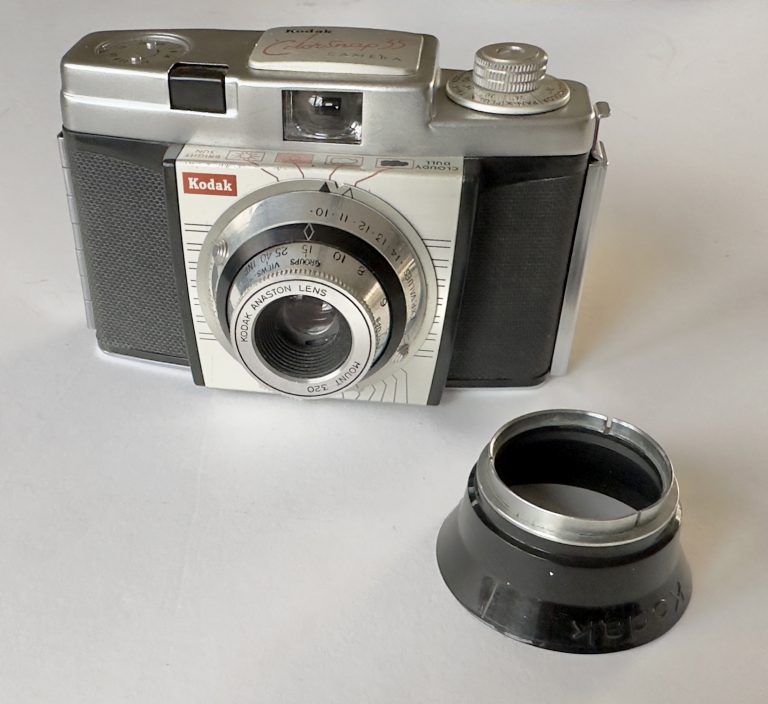
1960 Periflex 3a
This camera belonged to a childhood friend of my fathers, a trained Engineer and keen photographer. He bought it new from F.E.Jones of Rumford St. Liverpool together with a 100 f4 Lumar lens, viewfinder attachment and a set of filters. The original box and handbook came with the camera, together with a rather wonderful home-made gadget bag. When he became too old to use it, he gave it to my father to pass on to me, as he knew I collected cameras. According to the author of CORFIELD CAMERAS, A History & Collector’s Guide, John Lewis, my model looks to be a lovely example and it’s one of the earlier models with what he calls the ‘tube’ lens mount – it doesn’t have the later more chunky mount with finger grips which came with 3a’s not very long after production started and then went on to the Gold Star. So mine is a “true 3a” – as they were when first introduced – and the original box, seal, and instruction book makes it even more desirable”.
In 1959 the Periflex factory moved to Northern Ireland, and not long afterwards, this camera was introduced. The Periflex was made by the Corfield brothers Kenneth and John (K. G. Corfield Ltd) originally in Wolverhampton. It was unusual in that focusing was done by a Periscope that sat in the film plane and when the shutter was pressed it was quickly raised up. The shutter was focal plane and lenses were mounted using the, at the time, ubiquitous Leica screw mount. Lenses were Lumar (made by the British Optical Lens Company in Birmingham). The first Periflex (the Periflex 1) was introduced in 1953. Corfields also imported Exakta cameras from Ihagee in East Germany.

1963 Kodak VECTA
This camera was a present on my recent Birthday from my friend Steve, for whom I bought a book on prolific British designer Kenneth Grange (responsible for the successful Instamatic) as well as this camera.
It is a simple design, with a fixed focus lens of about f14 and a single shutter speed of around 1/30th second. It took 127 film, which at the time was starting to go out of fashion with the increasing popularity of 35mm (and Instamatic) film.
The shutter release is on the front, and the film chamber is accessed by the two lugs on either side. This example is mint, but is missing a film spool. The film winder is on the right, and the frame number is through the customary red window on the back.
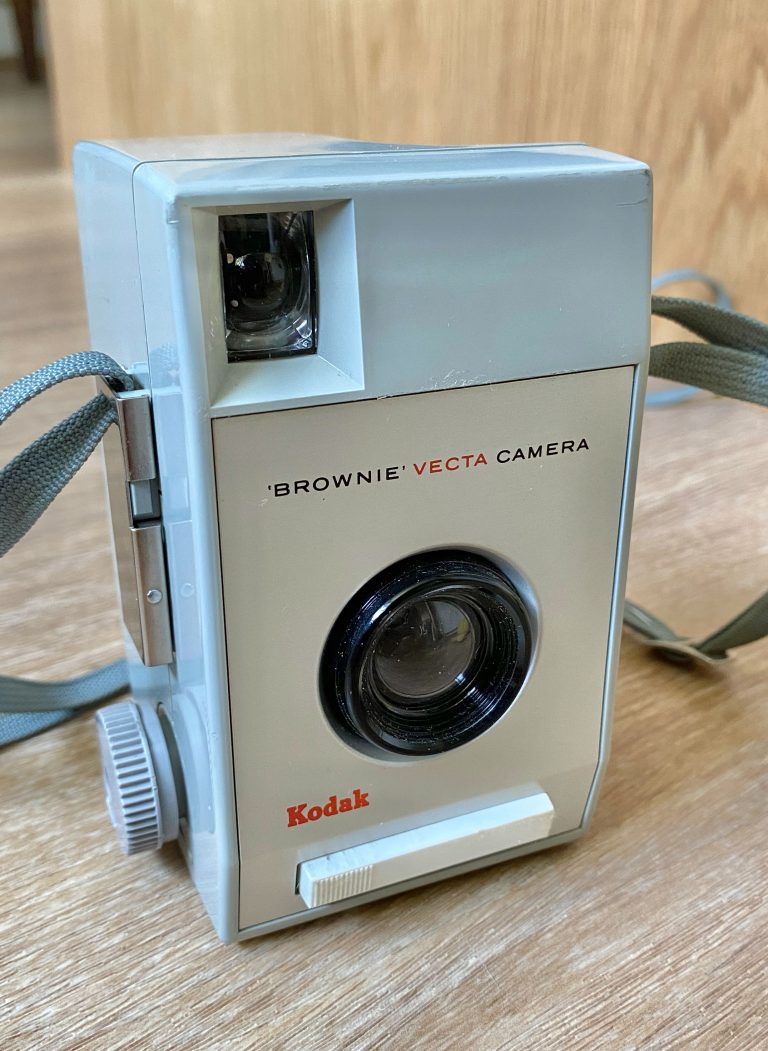
1966 Instamatic 25
The Kodak Instamatic 25 Camera is a simple point and shoot camera with a fixed aperture of f=11/43mm and 2 shutter speeds denoted by symbols for ‘sunny’ and ‘cloudy’. This example was made in England. It takes 126 ‘Kodapak’ film cartridges which simply drop in. This system was introduced in 1963 and has an image size of 28mm square. When the film is used up no rewinding was necessary, one simply removed the cartridge and sent it to be processed. The Instamatic 26 is a similar camera, but sold only through premium schemes. These are an early part of a long line of Instamatics – the 25 replacing the first Instamatic, the Instamatic 50. The Instamatic 25 was made from 1966 to 1972 by Kodak Ltd. (England) and Kodak Spain, to a design for the camera externals by Kenneth Grange. The Internals, including shutter mechanism were designed by Alex Gow. The camera has a two-speed shutter. Its speed selector can be shifted from the sun symbol (1/90 sec.) to the half-sun symbol (1/40 sec.) . The Kodak 1:11/43mm lens has fixed focusing and fixed aperture. The viewfinder is of reverse Galilean type. The flash shoe is for Kodalux bulb flashes.
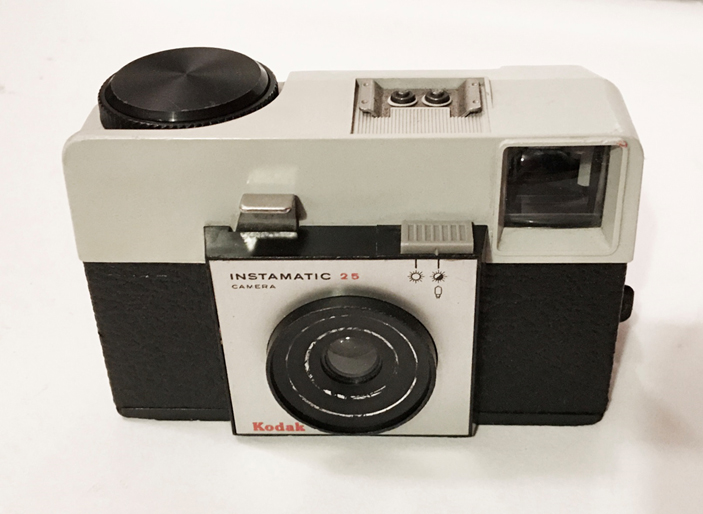
1968 Kodak Instamatic 233
Made in Harrow this camera had a 41mm F6.6 Reomar lens. It was a simple snapshot camera for 126 cartridge loading film, with a flashcube socket and a two-speed shutter – 1/40sec and 1/80sec, set by weather symbols on the lens barrel.
126 film is a cartridge-based film format used in still photography with a size of 28mm square. It was introduced by Kodak in 1963, and is associated mainly with low-end point-and-shoot cameras, although a few high-end models were made by Minolta, Rollei, Yashica and Zeiss Ikon.
A flashcube was a module with four expendable flashbulbs, each mounted at 90° from the others in its own reflector. For use it was mounted atop the camera with an electrical connection to the shutter release and a battery inside the camera. After each flash exposure, the film advance mechanism also rotated the flashcube 90° to a fresh bulb. This arrangement allowed the user to take four images in rapid succession before inserting a new flashcube.
The black leathercloth covering of this example has bleached, which I think is rather attractive!
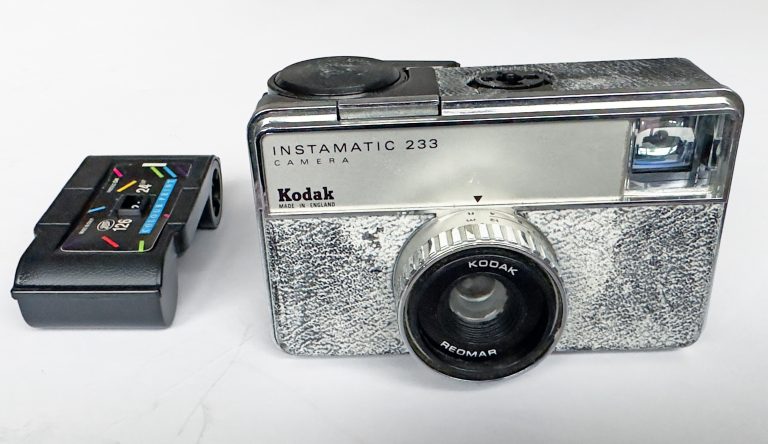
1970 Kodak Instamatic 133 Outfit
The difference between this camera and the 233 is that the 133 is much more basic. The 43mm lens has no name and has a fixed aperture of F11. There are 2 shutter speeds: 1/80 sec. (sunlight), and 1/40 sec. (dim light or flash) set with the lens barrel.
A later 133X was offered with the ability to take ‘Magicubes’ which do not need an internal battery to be triggered.
Both cameras were designed by Kenneth Grange.
